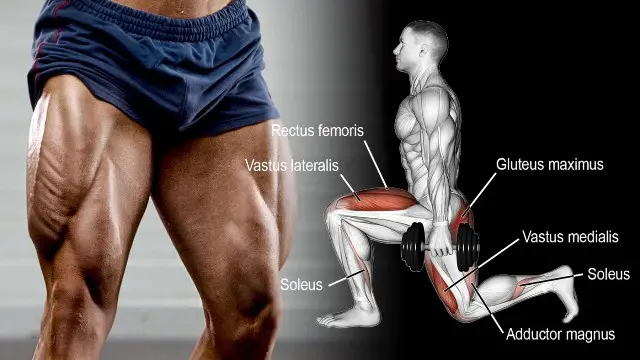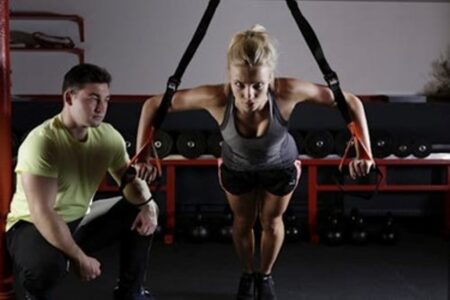Fostering growth in bodybuilding often requires a laser focus on strengthening and stabilizing every muscle group. Incorporating dumbbell leg workouts in your routine could serve as a potential game-changer. Not only do these exercises cater to the large muscle groups in your lower body, but they also indirectly impact your overall performance. By optimizing these workouts into your regimen, you can achieve more balanced bodybuilding outcomes, demonstrating the connection between lower body strength and overall physical prowess.
Dumbbell leg workouts offer a diverse range of benefits, from enhanced balance and stability to increased calorie burn due to stimulated muscle growth. Moreover, they instigate proprioception – the body’s ability to perceive its position in space, thereby enhancing body control during other workouts. This not only facilitates strength gains but also prevents potential injuries. Do not underestimate the power of these leg-based workouts with one of the most fundamental pieces of gym equipment, as they extend far beyond just transforming your quads and glutes. Check this bodybuilding site AllMuscles to learn more about workouts.
The Importance of Leg Muscles in Bodybuilding and Everyday Life
The strength and stability of leg muscles have more implications than just upgrading the aesthetics in bodybuilding. These muscles operate as the foundation, offering commendable assistance in improving overall athleticism and physical capabilities. Intentionally working on your leg muscles through strength and resistance training not only amplifies your bodybuilding efforts but also promotes a wide variety of real-life benefits.
Imagine your legs as the powerhouse fueling your fitness journey. Not only do they contribute to a well-rounded and symmetrical physique in bodybuilding, but training your legs can also lead to improved functionality. Leg strength can enhance speed, agility, and power, factors that influence activities as diverse as recreational sports, heavy lifting sessions, and even simple movements like walking or climbing stairs.
An interesting aspect tied to our leg muscles is the kinetic chain concept, which suggests a systemic interconnection among the joints in our body. In simple terms, strengthening your legs could inadvertently lead to improvements in other parts of your body, in line with the saying ‘strong legs, strong body.’ Focusing on leg day, therefore, doesn’t mean neglecting the upper body.
Furthermore, fostering leg strength can contribute to your overall health and well-being. Exercises like squats or lunges with dumbbells are known to release testosterone and human growth hormone, leading to increased muscle growth and fat loss throughout the body. Not to mention, they also assist in crucial aspects like maintaining healthy bone density.
So, the next time you hit the gym, don’t forget to embrace leg workouts full-heartedly. They hold the power to transform not only your bodybuilding routine but also your entire lifestyle and well-being. Building a powerful set of legs is not just about aesthetics, but it’s a holistic process to elevate body strength, balance, and functionality.
Here is a popular dumbbell leg workout that can be done at home: 20 Minute Dumbbell Leg Workout at Home – Squats, RDLs | Caroline Girvan
Related: INTERVIEW: Fitness Guru, Obruthe Talks Up Complete Sports Celebrity Workout For Healthier Nigeria
The Best Leg Exercises with Dumbbells
If you’re looking to supercharge your strength training routine, incorporating targeted leg exercises with dumbbells can be a vital step. Dumbbells are not only accessible but also incredibly versatile, lending themselves to a wide variety of exercises aimed at toning and strengthening your lower body.
One of the key exercises you can incorporate is the classic squat with a twist, also known as a dumbbell squat. Holding a dumbbell in each hand by your sides, lower your body as if sitting on an invisible chair, pushing your hips back and bending your knees. Go as low as your flexibility allows while maintaining the correct form before you drive back up, squeezing your glutes. This whole body exercise offers the dual advantage of improving muscle balance as well as enhancing muscle engagement.
Next in line is the lunges with dumbbells, a perennial favorite. Stand upright, holding a dumbbell in each hand, keeping your feet shoulder-width apart. Take a step forward with your right leg and lower your body until your front knee is bent at a 90-degree angle while keeping your torso upright. Push back to start, repeat on the left side. This quintessential leg exercise tones everything from your hips to your calves.
Another standout among the best exercises with dumbbells is the goblet squat. Grasp one end of the dumbbell with both hands at chest level while standing with your feet spread hip-width apart and perform a regular squat. This unique squat variation enables you to maintain a better posture and can be less taxing on the lower back.
These exercises are far more than just lower body workouts as they work multiple muscle groups simultaneously, leading to improved overall strength and balance. So don’t shy away from adding these dumbbell leg exercises to your routine. They’ll serve as the cornerstone of your strength training, aiding you in achieving your bodybuilding goals.
A Beginner Dumbbell Leg Workout Example
Embarking on a new fitness or workout regime can feel daunting, especially when trying to incorporate new exercises into your routine. Fret not – here is a beginner-friendly dumbbell leg workout designed to give you a fantastic starting point. This workout will aid in building a powerful foundation while also preventing any muscle imbalances and weaknesses.
To get started, warm up for about 5-10 minutes with a light cardio activity like brisk walking or jogging. Once you feel ready, begin with dumbbell squats, performing 3 sets of 10-12 repetitions. Hold a dumbbell in each hand by your sides while executing the squat, remembering to maintain proper form and drive through your heels to engage the glute muscles.
Next, transition to the stationary dumbbell lunges. This unilateral exercise (working one leg at a time) will not only work on your leg muscles but also help enhance your balance and stability. Hold the dumbbells at your sides and step forward with one leg into a lunge. Perform 8-10 repetitions for each leg, completing 3 sets in total.
After lunges, proceed to the dumbbell stiff-legged deadlifts, an excellent hamstring and glute focused exercise. Grasp a dumbbell in each hand, slightly bending your knees, and lower the weights towards your feet whilst keeping your back straight. Do 3 sets of 12-15 repetitions, focusing on engaging your hamstrings as you raise your upper body.
Lastly, include the dumbbell calf raises in your workout. Holding a dumbbell in each hand, stand upright on a flat surface or place the balls of your feet on an elevated platform. Raise your heels up as high as possible and lower them back down slowly, feeling an intense stretch in your calves. Aim for 3 sets of 15-20 reps, concentrating on your range of motion.
Remember, as a beginner, the key to success is consistency and gradual progression. Starting with this straightforward dumbbell leg workout provides a solid ground to subsequently include more complex exercises and variations into your training programs while remaining focused on proper form and control.
An Advanced Dumbbell Leg Workout Example
If you’ve been under the iron for a while and are always game for a challenge that can enhance your strength, an advanced dumbbell leg workout might be just what you need. Designed to help push your boundaries, this workout focuses on challenging your muscles and increasing your overall physical capacity. Maintaining the right form and monitoring your intensity levels throughout the workout will ensure an optimal experience with compelling results.
The first exercise to consider is the dumbbell split squat, a variation of the traditional squat, where one foot is positioned forward as in a stride. Hold a dumbbell in each hand and lower the body by flexing the knee and hip of your front leg. After that, return to the initial standing position by driving through the heel of your front foot, primarily engaging the quads and glutes. Perform 3 sets of 10 repetitions for each leg.
Next up is the dumbbell Bulgarian split squat, also known as rear-foot elevated split squat. Place the toes of your rear foot on an elevated surface (like a bench or step), taking a forward stance with the other foot. Holding a dumbbell in each hand at your sides, lower as far as comfortably possible with your front leg, then drive back up to stand. This exercise intensifies the recruitment of your quadriceps, hamstrings, and glutes. Aim for 2 sets of 8-10 reps on each leg.
Adding to the intensity, the walking lunges with dumbbells are also a great option. Similar to standard lunges, this exercise involves walking forward with each lunge, while holding dumbbells at your sides. This variant can significantly improve your lower body strength and mobility, as it is a bit more dynamic than a stationary lunge. Execute 2 sets of 20 steps each, alternating between legs.
Finally, switch to single-leg calf raises, where you’ll challenge your stability while strengthening your calf muscles. Standing on one foot, hold a dumbbell in the opposite hand for balance and perform calf raises, 2 sets of 15 reps on each side.
This advanced workout certainly isn’t for the faint-hearted, but it’s perfect for those who love to test their limits. Always remember to listen to your body and adjust the weights and sets according to your capacity. Embrace the challenge, train smart, and witness your body grow stronger and more powerful.
Here is another leg workout that has been proven effective for many people: The Best Science-Based DUMBBELL Legs Exercises For Size And Symmetry
Related: Pathways To Fitness: Healing Your Mind, Body And Soul
Dumbbell Leg Exercises to Avoid
While incorporating dumbbells into leg workouts can be highly beneficial, it is essential to approach these exercises with care and knowledge. Some dumbbell leg exercises might not be the most effective, could pose potential risks or may just not be the best choice, especially if you’re not an advanced trainee. Exercising discernment in your workout regimen will help you optimize your efforts while avoiding unnecessary stress and injury.
Deep squats with dumbbells may put a lot of pressure on your lower back if executed incorrectly. For individuals with limited mobility or those lacking proper form, this could lead to straining the lower back and affecting it negatively. Prioritizing proper squatting technique and developing core strength before incorporating dumbbells in deep squat positions can help prevent potential mishaps in this area.
If you’re struggling with balance issues or are new to exercising, single-leg dumbbell exercises might be worth avoiding for the time being. Examples include single-leg Romanian deadlifts or single-leg squats. While these exercises help improve balance and stability, they require a certain level of proficiency to execute promptly. Beginners should focus on mastering the form and technique of their bilateral counterparts before advancing to single-leg variations.
Another point of caution involves dumbbell leg exercises performed at high speeds with ballistic movements, such as jump squats or jump lunges. These movements may not be well-suited for beginners or those with joint issues, as they require a strong foundation in terms of strength, conditioning, and skill. Jumping exercises can place significant stress on the knees, and the added resistance from dumbbells may exacerbate the problem.
In conclusion, the road to achieving a strong lower body using dumbbells should be navigated mindfully. Prioritizing controlled movements and focusing on appropriate exercises that match your skill level will yield the best results while increasing overall stability and strength. Take the time to build a strong foundation by learning the correct techniques, listen to your body, and, most importantly, never be afraid to seek professional advice when necessary to maximize your workouts effectively.
Mistakes to Avoid When Doing Leg Dumbbell Workouts or Exercises
Dumbbell leg workouts notoriously push your limits, incite muscle development, and cultivate strength. However, for their numerous benefits, best practices need to be observed to avoid mistakes that could hinder progress and potentially lead to injury.
One of the most common mistakes when using dumbbells for leg workouts is compromising on form. When lifting weights, form should not be compromised for the sake of lifting heavier. Whether it’s an improper squat depth, incorrect posture during lunges, or a rounded back during deadlifts, poor form can lead to various risks, including muscle strains and imbalances. Your prime target should always be executing movements with precision and control.
Another potential error is neglecting the importance of a balanced workout. Over emphasizing on exercises that target specific muscles, like quadriceps, without giving equal attention to other muscle groups, like hamstrings and calf muscles, can lead to muscle imbalances. This can not only affect your physique aesthetically but may also increase your susceptibility to injuries.
Skipping the warm-up or cool-down is an unfortunately common oversight that can hinder your success. A proper warm-up helps prepare your body and muscles for the demands of a workout, increasing your performance, while the cooldown assists in bringing your body back to a restful state, aiding in recovery. Shortening or skipping either one might have negative implications on both your workout performance and recovery time.
Lastly, while it is generally advantageous to regularly push your boundaries, it is critical to recognize individual limitations and not to overdo it. Progressing too quickly, especially with heavier weights, can overload your muscles and joints, leading to an increased risk of injury. Incrementally increasing weights while keeping good form should be your mantra.
By avoiding these mistakes and following the correct exercise protocols, you can ensure that your dumbbell leg workouts are both safe and effective while bringing you closer to your strength and fitness goals. Training smart is as important as training hard, and the journey to fitness is a marathon, not a sprint.
Muscle Recovery After Leg Dumbbell Workouts
After giving it your all during an intense round of leg exercises with dumbbells, your body needs to recover adequately. Your muscles aren’t built during workouts but during post-workout rest periods when they repair and become stronger. To ensure effective muscle recovery, there are a few key principles to consider.
Firstly, nutrition plays a vital role in recovery. Aim to consume a balanced meal of protein and carbohydrates within an hour or two post-exercise. Protein-rich foods aid muscle repair, while carbohydrates replenish your energy stores. Remember, it’s not about overeating but refuelling with the right nutrients.
Another important element is hydration. Engaging in workouts, especially intense ones, tends to dehydrate your body heavily because of the copious amounts of sweat released. To help your body recover and function properly, replenish it with enough fluids. Water is essential, but occasionally, a hydrating drink with essential electrolytes could be beneficial.
Post-workout stretches and movement also contribute significantly to recovery. They help improve flexibility, stimulate blood flow to the muscles, and alleviate potential muscle stiffness that might come after an intense workout. Gentle movements, like a mild walk or yoga poses focusing on the lower body, can enhance recovery.
Lastly, but definitely not the least, is rest. Allowing your body ample time between workouts to recover is paramount. Most recommend at least 24-48 hours of rest period between intense leg workouts. Listen to your body, rest adequately, and ensure you’re getting quality sleep because a lot of muscle repair and growth also occurs during sleep.
Through careful attention to these fundamental components, you can establish a successful recovery routine. Together with your workout routine, your muscle recovery practices can immensely contribute to sustainable fitness progress, giving you the strength and health to keep achieving your exercise goals.
Foods that Help the Leg Muscles Get Stronger
A well-rounded workout routine certainly contributes to stronger leg muscles, but your diet plays an equally pivotal role. Incorporating key nutrients into your meals can stimulate muscle growth, improve strength, and expedite recovery.
Foremost among nutrients is protein, given its role in building and repairing muscle tissue. Foods like lean meats such as chicken, turkey, and fish are perfect protein-packed assets for your diet. Don’t forget plant-based proteins as non-animal alternatives, like lentils, quinoa or tempeh, which can be versatile choices too.
Complex carbohydrates also provide a crucial piece of the puzzle when it comes to muscle development. They serve as your body’s primary energy source, powering your workouts and supporting recovery. Foods like whole grains, brown rice, and sweet potatoes are great selections.
There’s also a place on your plate for healthy fats, which support overall health and promote nutrient absorption. Avocados, nuts, seeds, and olive oil are examples of foods rich in unsaturated fats that help keep your muscle-building machine running smoothly.
Don’t skip on vegetables and fruits, they’re packed with essential vitamins, minerals, and antioxidants that support overall health, including muscle function and recovery. For instance, foods high in Vitamin C like oranges can help combat muscle soreness, and potassium-rich bananas can help maintain muscle function. Leafy greens are also beneficial owing to their high magnesium content, supporting muscle contractions.
It also pays to plan your nutrition, timing your meals to best support your fitness routine. Eating a balanced meal with complex carbs and protein post-workout can help enhance muscle recovery and growth. Hydration, too, is vital; maintaining fluid balance impacts physical performance and recovery.
By integrating these nutrient-dense foods into your diet, you can give your leg muscles just what they need to get stronger. Providing the right fuel for your body, along with maintaining an effective workout routine, paves the way for peak fitness performance and superior muscle strength.
Conclusion
In the grand scheme of fitness, understanding the dynamics of dumbbell leg workouts, their potential pitfalls, and effective recovery practices can go a long way in ensuring your journey is both rewarding and fruitful. Couple this with nutrition that fuels and fortifies your body, and you create a solid foundation for achieving stronger, more powerful legs.
Remember, fitness is not merely about working on aesthetics but also about fostering healthier, stronger bodies that are more resilient. Being conscious of your form during workouts, giving your body the rest it needs, and supplying it with the right nutrients will help you navigate on the path to strength. By keeping these fundamentals in mind, your journey to superior fitness will certainly be a journey well navigated.





